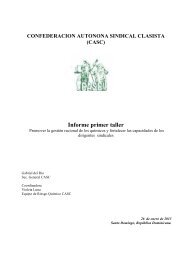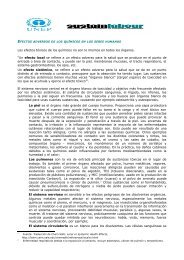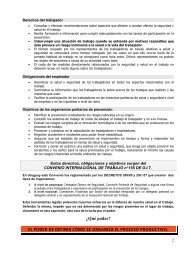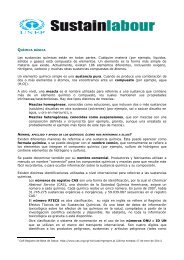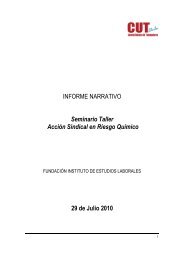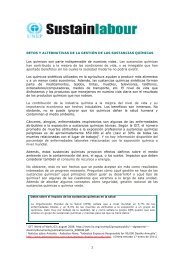Non-Communicable Diseases and Environmental Determinants
Non-Communicable Diseases and Environmental Determinants
Non-Communicable Diseases and Environmental Determinants
You also want an ePaper? Increase the reach of your titles
YUMPU automatically turns print PDFs into web optimized ePapers that Google loves.
NCDs <strong>and</strong> <strong>Environmental</strong> <strong>Determinants</strong> 3<br />
Introduction: NCDs – a leading <br />
cause of death worldwide <br />
Genon Jensen, HEAL <br />
This briefing paper aims to provide latest knowledge on<br />
<strong>Non</strong> <strong>Communicable</strong> <strong>Diseases</strong> from some of the leading<br />
experts <strong>and</strong> organisations from four perspectives:<br />
women’s organisations, health sector, developing<br />
countries <strong>and</strong> trade unions. Each chapter identifies the<br />
links of NCDs with environmental pollution in these 4<br />
areas <strong>and</strong> shares priorities for preventive policy action as<br />
well as sharing instructive case studies. The paper clearly<br />
demonstrates environmental factors as major<br />
determinants for NCDs, <strong>and</strong> the related challenge for<br />
sustainability; it outlines opportunities to prevent NCDs<br />
by addressing their environmental determinants with an<br />
emphasis on the framework provided by the Children’s<br />
Environment <strong>and</strong> Health Action Plan for Europe<br />
(CEHAPE) <strong>and</strong> the Parma Declaration on Environment<br />
<strong>and</strong> Health in the European Region 1 to prevent disease<br />
arising from chemical, biological <strong>and</strong> physical<br />
environments.<br />
This briefing is for decision-makers in the following fora<br />
or processes: the European Environment <strong>and</strong> Health Task<br />
Force (EEHTF) meeting, the WHO Regional Committee<br />
for Europe (WHO/RC), the UNECE Committee on<br />
<strong>Environmental</strong> Policy (UNECE/CEP), UNEP Global<br />
Major Groups <strong>and</strong> Stakeholders Forum (GMGSF) in<br />
2013 <strong>and</strong> the SAICM Health Sector Strategy, the WHO<br />
post-2015 consultations on a new Global Goal on Health<br />
(to follow on the Millennium Development Goals) <strong>and</strong><br />
on the development of Global Action Plan for the<br />
Prevention <strong>and</strong> Control of NCDs (2013 to 2020) 2 .<br />
NCDs are now the leading cause of preventable<br />
morbidity <strong>and</strong> related disability, <strong>and</strong> thus significantly<br />
affect the wellbeing of many individuals <strong>and</strong> workers‘<br />
daily lives. In parallel, the burden of these diseases on<br />
those suffering <strong>and</strong> the associated health care costs<br />
continue to rise exponentially. In all OECD countries<br />
increase in health care costs have consistently outgrown<br />
GDP growth for the last 40 years, <strong>and</strong> often without a<br />
commensurate increase in positive health outcomes.<br />
The ground-breaking UN Summit on <strong>Non</strong>-<br />
<strong>Communicable</strong> <strong>Diseases</strong> 3 in September 2011 in New<br />
York was prompted by recognition of the growing burden<br />
of cancer, cardiovascular disease, respiratory illnesses,<br />
<strong>and</strong> diabetes around the world, <strong>and</strong> the toll it was taking<br />
on families, healthcare systems <strong>and</strong> economies. These<br />
illnesses, also known as chronic, non-communicable<br />
diseases (NCDs) are the leading cause of death<br />
worldwide, resulting in an estimated 36 million deaths<br />
annually <strong>and</strong> hitting developing countries the hardest<br />
(where 80% of deaths occur).



